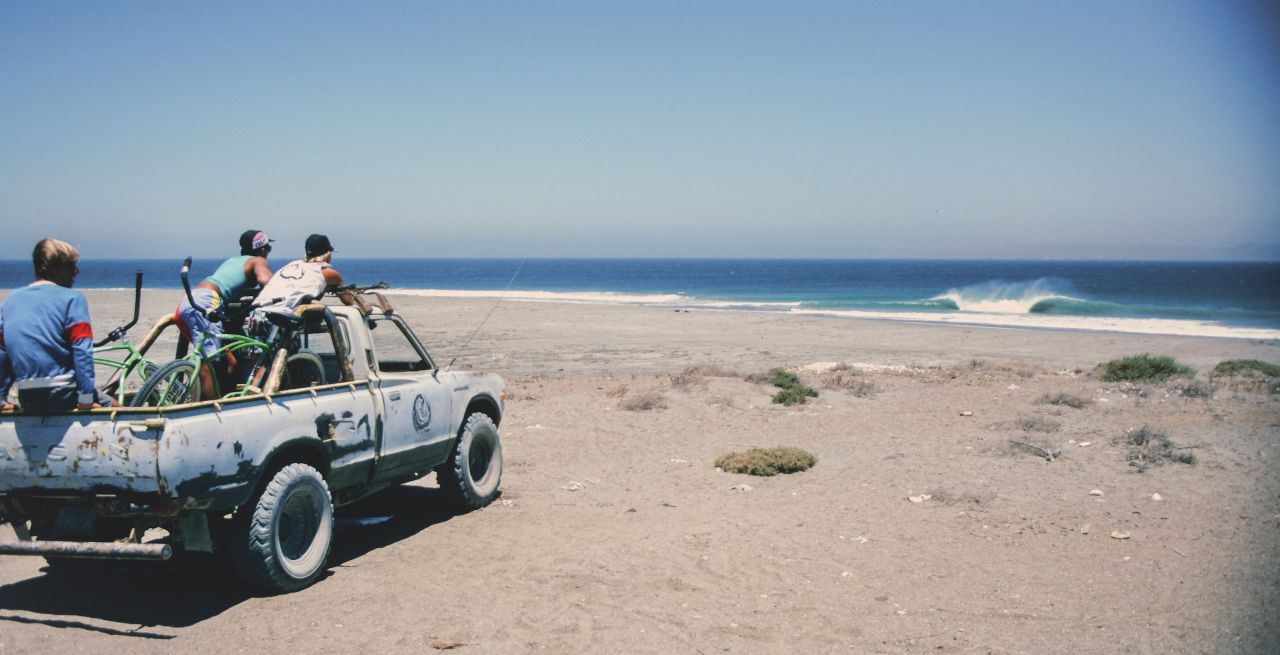
Invariably, though, it’s Drollet who finds himself in the best spot on the biggest waves that come through. And it’s not by accident. Drollet’s earned it the hard way: one late drop after another, swell after swell, year after year.
Page 80
Top Dead Center
Look all the way to the edge of the reef at Teahupo‘o and you’ll find Matahi Drollet sitting quietly by himself.

You can look at that board and see the point at which a 16-year-old’s artistic DNA started commanding the lexicon of decades’ worth of youth culture and street art.
Page 66
Propelled on a Zephyr of Compressed Wind
CR Stecyk, the Smithsonian, and the first airbrushed surfboard.

Page 26
The Jewel of the South
Campeche is everything you never knew about Brazil.

I’d be off surfing some little wave and we wouldn’t see each other the whole trip. But I kept hearing, “Your dad was fucking charging today!” Mick Short would tell me, “Your dad was out at Boat Ramp and it was real and proper, and he was sending it!”
Page 20
Full Nurture
An interview with Noa Deane.

Page 40
Views From Kaimuki
Joey Hamasaki was an Ala Moana beacon. Respected and championed by surfing’s more referenced players, her trajectory laid out a pan-Pacific surf path from Town and back again.
Support independent surf journalism.
Become a member.

Reid then met with representatives of a Europe-based camera company, who offered to buy him out and make him a millionaire on the spot. He wasn’t convinced. To someone who had squatted in shanties and hidden from cops as a boy, what really did he have to lose by looking for something bigger?
Page 56
Running Like God
Inventor and Black Butch descendant Tyler Reid is on a heater.

The gringo’s birthday was cause for celebration. Cans of beer topped the sole picnic table. An elderly man in a cowboy hat played a guitar and blew into a harmonica. Kids lit firecrackers and threw them into the night. After the first bottle of tequila was finished, a second one came out. There were no glasses. We swigged from the bottle and passed it along.
Page 92
The Beautiful Flower Will Wilt, the Beautiful Flower Will Die
Recalling A-frames and growing pains on a Baja rock patch in the go-go 1980s.

Page 100
Portfolio: Nick LaVecchia
With a singular aesthetic, Nick LaVecchia makes the rugged look nearly enticing.

The apartment is shin deep in water, and we talk through the pros and cons of opening the door. It boils down to this: We can go outside. We don’t know what’s out there.
Page 16
Essay: Meet the Maker
A Filipino breakfast in the teeth of Typhoon Lando.
The Surfer’s Journal is the perfect gift for every surfer.

Page 50
Jam Econo
Beachside, street life, and other intimate moments through the lens of San Pedro’s Nick Green.

Page 118
Undercurrents
A North Shore outer reef in all of its 12-feet-at-20-second, buoy-bouncing glory—as sniped by environmental scientist Aaron Ungerleider atop his post at the Kawailoa Wind Farm—serves as a fitting drop into the issue’s departments.

“Security also told me that I couldn’t stay overnight, which is wrong. I pushed back and got ‘permission’ from them to camp on public land. The next day, I took a drive north to find the Tormin mine on the beach, and could see new roads, trucks, and diggers all hard at work ripping up the coastline.”
Page 120
Field Report
Mine Hunters: Surfers are standing in the way of the destruction of South Africa’s west coast.

Page 121
Community Service
Spearos of Death Metal: Tom Flambeaux is cleaning up poisonous lead under the ocean’s surface one breath at a time.
Purist surf energy from Page One to close-of-book, delivered directly to your door.

Page 122
Miscellany
How to avoid getting mugged in the lobby of an AC casino, the necessities of surfboard basting, and an only three-chords-needed playlist pulled from 1980s San Pedro.

The author draws a line through Polynesia, Peru, and Hawaii before tackling California and the rest of the world. San Onofre’s phases as a coastal track—Indigenous lands, Mexican rancho, cattle range, military training grounds, “surf beach,” and state park—are encompassed along that line while exploring how surfing can become a centering lifestyle with all its trappings.
Page 124
Surfing Around
No Cobblestone Left Unturned: Reviewing the exhaustive history of San Onofre.









